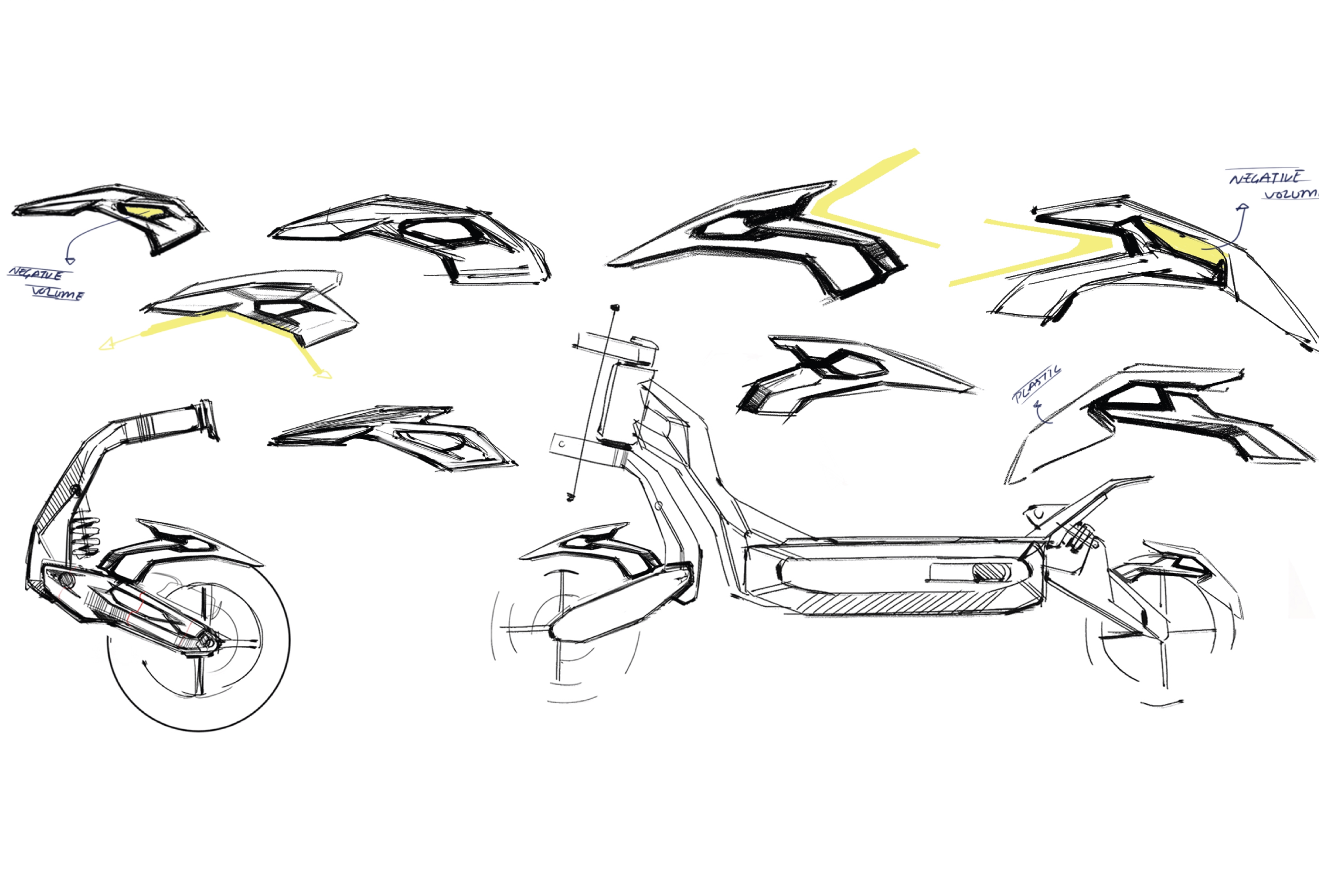Seamos sinceros: no diseñamos ni fabricamos este patinete. Nos asociamos con una fábrica cuyo equipo de diseño incluye a antiguos diseñadores industriales de Polaris (cuatrimotos y carritos de golf). Nuestro papel fue elegir al socio adecuado, ajustar las especificaciones y negociar un precio justo. Sin complicaciones ni rodeos. Solo facturas y bocetos.
TL;DR
-
Origen: Diseñado por el equipo de nuestro socio de fábrica (varios diseñadores trabajaron anteriormente en los programas de vehículos todo terreno y carritos de golf de Polaris).
-
Enfoque: Una remezcla de ideas probadas en scooters: las mejores características de modelos populares combinadas en una sola plataforma.
-
La función de Voro: Selección de especificaciones, necesidades del cliente, facilidad de mantenimiento, suministro de repuestos y control de precios.
Esta publicación es una cronología visual —desde los primeros bocetos en servilletas hasta las hojas de concepto refinadas— además de notas sobre qué cambió y por qué.
Créditos y divulgación
-
El diseño de Hooga Daytona pertenece a nuestro socio fabricante.
-
Entre los diseñadores se incluyen profesionales con experiencia previa en programas de Polaris. No existe ninguna afiliación ni respaldo por parte de Polaris .
-
VoroMotors se encargó de la selección de especificaciones, las pruebas de validación, los ciclos de retroalimentación, la estrategia de repuestos y la estrategia de lanzamiento al mercado.
(Polaris es una marca registrada de Polaris Inc. Se menciona aquí únicamente para describir la experiencia previa de los diseñadores individuales).
¿Por qué ganó este diseño?
Analizamos decenas de patinetes y luego le pedimos a la fábrica que combinara elementos clave : la estabilidad de los cruisers de batalla larga, la facilidad de mantenimiento de las plataformas modulares, la iluminación de los patinetes urbanos con iluminación integrada y una disposición de la batería y el controlador que mantiene el centro de gravedad bajo. Resultado: una plataforma que se siente familiar desde el primer día y que no te costará un ojo de la cara.
El cuaderno de bocetos (leyendas de la galería)
1) Exploración de siluetas: postura e inclinación
Lo que ves: Estudios de trazada rápida que ponen a prueba la distancia entre ejes, la caída de la plataforma y el ángulo del tubo de dirección. Por qué es importante: El equilibrio entre estabilidad y agilidad empieza aquí. 
2) Bastidor y soporte de batería
Lo que ves: Secciones transversales de una columna central reforzada con un compartimento de batería accesible. ¿Por qué es importante?: Centro de gravedad bajo, cambios de batería más sencillos, cableado más ordenado.

3) Iteraciones del basculante
Lo que ves: Conceptos de basculante triangulado para gestionar la torsión bajo carga. Por qué es importante: Rigidez en la parte trasera sin añadir mucho peso.

4) Geometría de la tabla y postura de los pies
Lo que ves: Plataforma de fácil acceso, espacio para los talones y posiciones de sujeción. Por qué es importante: Comodidad en recorridos largos y mejor control al frenar.

5) Refrigeración y flujo de aire del controlador
Lo que ves: Aletas pasivas y conductos de aire dirigidos. Por qué es importante: Mantiene un rendimiento constante en días calurosos.

6) Guardabarros y gestión de salpicaduras
Lo que ves: arcos de cobertura, bordes que repelen el barro. Por qué es importante: ciclistas reales, condiciones climáticas reales.

7) Mecanismo de plegado y cierre
Lo que ves: Geometría de la palanca y bloqueos de seguridad. Por qué es importante: Sensación de firmeza sin riesgo de pellizcos en los dedos.


8) Combinaciones de colores y superficies
Lo que ves: roturas de paneles, pintura frente a textura, zonas de marca. Por qué es importante: fácil de mantener actualizado con colores de edición limitada.


La nomenclatura de las combinaciones de colores ha cambiado a Panda y Bicolor.

¿Qué cambió del boceto a la producción?
-
Mapa de aceleración y frenado: control de baja velocidad más suave; sensación de frenado más potente y constante. También conocido como acelerador de dedo inverso.
-
Neumáticos y llantas: goma con especificaciones que equilibra agarre y autonomía en llantas de 13 pulgadas, en comparación con la hoja de ruta inicial del producto de 11 pulgadas.
-
Elementos de fijación: herrajes resistentes a la corrosión en las zonas expuestas.
-
Arnés: cableado más limpio con desconectores rápidos etiquetados para facilitar el mantenimiento.
La filosofía del “remix”
Los grandes productos rara vez reinventan la física; simplemente reorganizan los ingredientes clave. Daytona combina una geometría en la que ya confías, una disposición de batería y controlador que se mantiene fresca y estable, y un ecosistema de repuestos que podemos abastecer durante años. Rendimiento sin complicaciones. Precio sin sorpresas.
Preguntas frecuentes (respuestas directas)
¿Diseñó Voro la Hooga Daytona? No. El diseño es obra del equipo de nuestro socio fabricante (que incluye a antiguos diseñadores de Polaris). Seleccionamos las especificaciones clave, la ajustamos, la validamos y le brindamos soporte.
¿Está involucrada Polaris? No. Algunos diseñadores trabajaron anteriormente en programas de Polaris; esa es toda la conexión.
¿Por qué llamarlo “remix”? Porque combina características probadas de scooters populares en una plataforma única y coherente a un precio justo.
¿Qué controla Voro? Especificaciones, requisitos de mantenimiento, suministro de piezas, documentación y soporte al cliente.
Llamada a la acción
-
Vea el producto final y el patinete de cerca: https://www.voromotors.com/products/hooga-daytona-72v-all-terrain-hyper-scooter
-
Mira el unboxing/transmisión en vivo: https://www.youtube.com/live/qWRlSysxLe8?si=Nag6l4EDA3yAcr4Q
-
Pregúntanos lo que quieras: Deja tus preguntas en los comentarios o en nuestro grupo de Reddit ; prepararemos una publicación de seguimiento.



